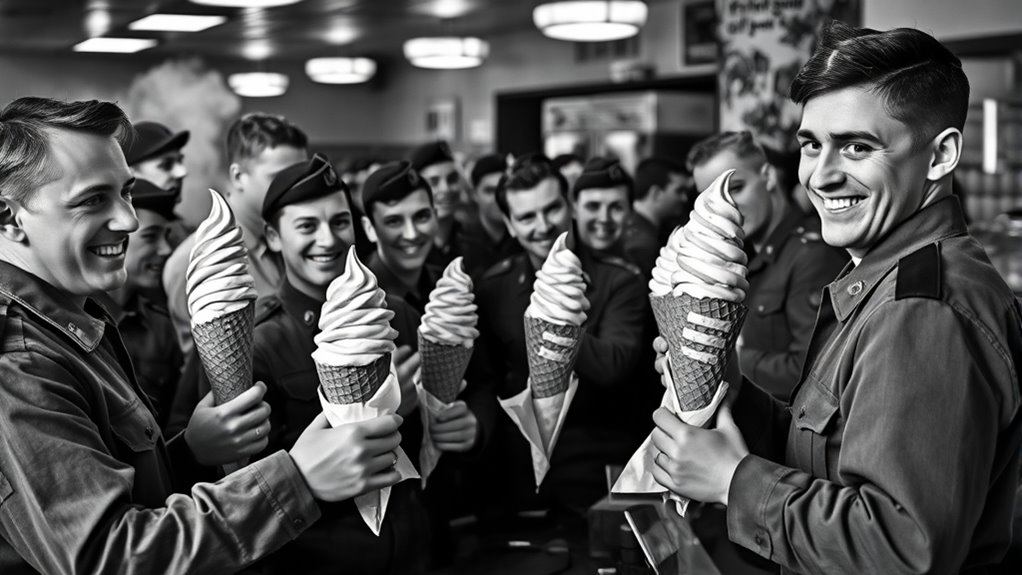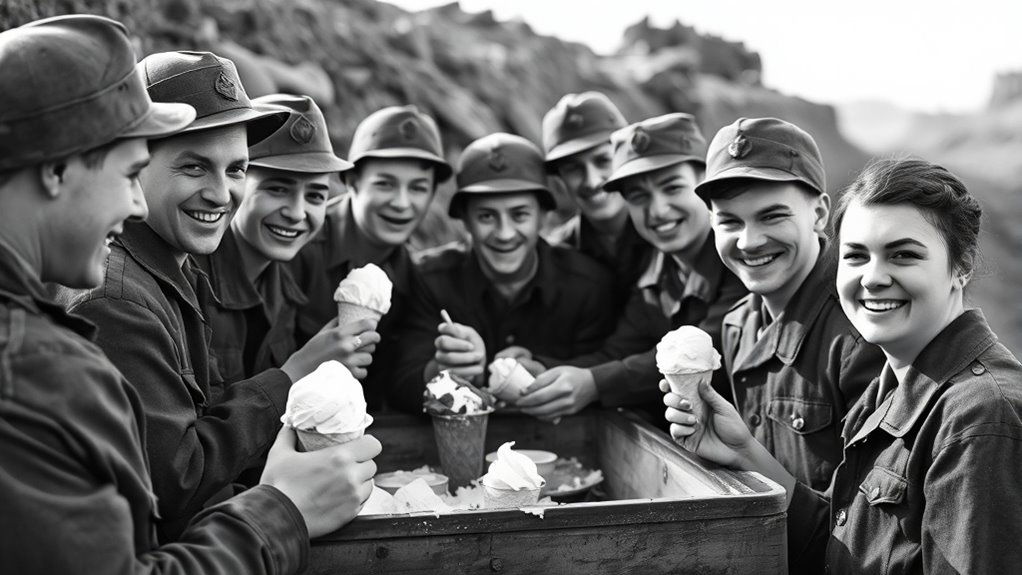During World War II, ice cream became more than a sweet treat; it symbolized resilience and boosted morale despite rationing. Troops and civilians found ways to enjoy it within strict limits, creating moments of normalcy amid hardships. Governments promoted ice cream to lift spirits, fostering unity and hope. Small joys like this helped people cope and stay strong. If you keep exploring, you’ll discover how this simple indulgence played a vital role in wartime morale.
Key Takeaways
- Ice cream boosted morale among troops and civilians, serving as a symbol of normalcy during wartime hardships.
- Rationing restrictions led to creative recipes, making ice cream a carefully managed treat rather than an everyday luxury.
- Military and civilian initiatives promoted ice cream as a morale booster and a symbol of resilience.
- Governments used propaganda to encourage rationed ice cream consumption, emphasizing small luxuries’ importance.
- Sharing ice cream fostered camaraderie and provided brief relief from wartime stress, strengthening community spirit.

During World War II, ice cream might seem like an unlikely soldier in the war effort, but it played a surprising role in boosting morale among troops and civilians alike. With wartime rationing tightly controlling food supplies, even something as simple as ice cream became a carefully managed treat. Rationing meant you couldn’t indulge freely; every ounce of sugar, milk, and butter was allocated with strategic purpose. Despite these restrictions, governments and local communities found creative ways to include ice cream in morale boosting strategies. They recognized that small moments of sweetness could lift spirits during difficult times, offering a brief respite from the hardships of war.
During WWII, ice cream boosted morale despite rationing and shortages, offering brief moments of comfort and unity.
You might not realize it, but during the war, ice cream served as a symbol of normalcy and comfort. Military bases and factories often set up special ice cream stands, knowing that a cold scoop could provide a much-needed break from the stress of daily routines. Civilians, too, found ways to enjoy ice cream within the limits of wartime rationing. Home cooks and community organizations shared recipes that used rationed ingredients, turning limited supplies into delightful treats. These efforts created a sense of unity, proving that even under restrictions, people could still find joy and connection through shared experiences.
The government understood the importance of morale boosting strategies, and they actively promoted ice cream as a morale booster. Propaganda campaigns highlighted the importance of maintaining morale and encouraged civilians to enjoy small luxuries whenever possible. In some cases, special “Victory Ice Cream” days were organized, where families could indulge in a rationed scoop, symbolizing resilience and hope. Military leaders recognized that keeping troops motivated was just as essential as supplying them with weapons; providing ice cream at bases was seen as a way to foster camaraderie and relieve stress during long deployments.
You’d notice that these efforts weren’t just about the ice cream itself—they were about the psychological benefits. The act of sharing a sweet treat created a sense of normalcy and comfort that soldiers and civilians desperately needed. Even with rationing rules in place, communities found ways to adapt, ensuring that morale boosting strategies included small pleasures like ice cream. These initiatives also highlighted the importance of nutrition in maintaining overall health and resilience during wartime. In this way, the humble scoop became a powerful tool for maintaining spirits amidst the chaos, proving that sometimes, a simple scoop of ice cream was more than just dessert—it was a symbol of resilience, hope, and unity during a challenging time.
Frequently Asked Questions
How Did Ice Cream Production Change During Wartime Shortages?
During wartime shortages, you’ll find that ice cream production slowed down considerably. Manufacturers often used ice cream substitutes and wartime recipes to stretch ingredients, making it easier to conserve dairy and sugar. This meant fewer traditional ice creams and more innovative options. You might notice that ice cream became less available, but the creative use of substitutes helped maintain some level of enjoyment and morale during tough times.
Were There Specific Flavors Popular Among Soldiers or Civilians?
During World War II, certain frozen treats and flavor trends gained popularity among soldiers and civilians. You’d notice that vanilla remained a classic favorite due to its simplicity and widespread availability. Soldiers also enjoyed chocolate and fruit flavors like cherry or strawberry, which boosted morale. These flavor trends helped maintain a sense of normalcy and comfort amid wartime hardships, making ice cream an essential morale booster during those challenging times.
Did Rationing Affect Ice Cream Availability in Different Countries?
Rationing definitely impacted ice cream availability across countries, limiting access much like other scarce goods. You see, wartime flavor adaptations emerged, with ice cream marketing shifting to emphasize novelty and morale boosts. Rationing led to smaller portions, alternative ingredients, and creative recipes to keep spirits high. So, your favorite treat became a symbol of resilience, with each scoop reminding you of wartime ingenuity and the importance of maintaining joy amidst hardship.
How Did Ice Cream Marketing Adapt During Wartime?
During wartime, you see ice cream marketing adapt through military promotions and wartime branding. Companies linked their products to patriotism, using slogans and packaging that emphasized supporting the war effort. They also sponsored events for troops and civilians, boosting morale. This strategy kept ice cream appealing despite rationing, creating a sense of unity and pride. Your favorite brands transformed their marketing to reflect the patriotic spirit, making ice cream a symbol of resilience.
Were There Any Notable Ice Cream Innovations Due to Wartime Needs?
During wartime, you’d think ice cream innovations were as rare as peace talks, but surprisingly, they weren’t. You see, wartime dairy substitutes led to creative ice cream flavor innovations, blending unfamiliar ingredients into sweet treats. These innovations helped boost morale, proving even in tough times, you can still indulge. So, you get inventive flavors born out of necessity, turning rationed ingredients into delightful surprises that made soldiers and civilians smile.
Conclusion
During World War II, ice cream wasn’t just a treat; it boosted morale and brought comfort amid chaos. Imagine a soldier savoring a rare scoop during a tough deployment, feeling a moment of normalcy and happiness. Just like that soldier, you can see how a simple pleasure like ice cream provided hope and a reminder of home. It’s proof that even small joys can make a big difference during difficult times.









